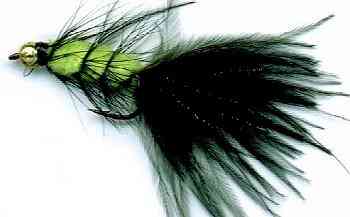The Beaded Viva Woolly Bugger Fly
The Woolly Bugger fishing fly pattern has to be one of the most versatile and productive flies around. The marabou tail and in most cases a palmered body suggest succulent small juvenile bait fish, insect larva, tadpoles or leeches that trout, bass and steelhead devour

WOOLLY BUGGER STREAMER FLY PATTERN. Hook size 10 4 2 - $US each
VIVA FLY PATTERNS
The fly fishing term 'VIVA' is now used to describe a killer color combination of very light green and black. It was first used by an English fly-dresser called Victor Furze. He used to work at the Vauxhall car making plant where the Vauxhall Viva car was made. He named a very successful black streamer lure with a very light green butt that he designed after the car he helped make. The original was intended to imitate the caddis larvae that made their homes in the rotting corm stalks on the bed of the new Draycote reservoir that had recently flooded the corn fields. The light green was the lava sticking it's head out of its dark cased body. For me it is the colour combination that works. It suggests a baitfish with a dark back and a light green lower body.
Reservoir Bank Fishing tips
I really enjoy fishing very early in the year on Reservoirs for two main reasons. The first is that a large number of trout would have been recently introduced to the water for the new season by the water keepers. These newly stocked fish tend to swim in shoals that are large in number and a relatively easy to catch. The second more attractive reason is that there will not be many other fishermen brave enough to face the chilly weather. This causes the trout to drop their guard as they have not been subjected to a lot of fishing pressure at this point. I find March is best. Many fly fishermen seem to wait until April or May to start their fishing year so they benefit from the prolific midge buzzer hatches.
In March the first areas to see fish feeding action are the shallows near the bank. With winter only just passing the water temperatures are still generally cold. The spring sun warms the shallows first and this is the zone that sees the first insect activity. In March the bank angler is at an advantage unlike in the heat of the summer where the boat fly fisherman wins with his ability to search out the cooler deeper water where the fish hide from the intensity of the sun.
Here are a few on my top tips for early season big water bank fishing. Waders are useful. Fish the water immediately in front of you before wading. Sink-tip and intermediate lines will get your flies to the fish. Slow to medium retrieves with jerky pulls work well. Keep trying different areas until you find the fish. Usually, once you catch one, more will follow because rainbows tend to shoal. By fishing a streamer wet fly with a nymph tied on a dropper you have the chance of hooking the fussier fish. Always ask the fishery staff’s advice as to the best location to try first. Make sure you wear lots of worm waterproof clothing and take a couple of flasks of hot drinks and soup.
I find the following flies are the best producers of fish in March: Beaded Viva (green and black) Woolly Bugger, Yellow Cats Whisker, large Black Epoxy Buzzer on point and on a dropper 6ft above the point fly a Pheasant Tail Nymph, Diawl Bach, Princes Nymph or Gold Ribbed Hare’s Ear Nymph. My ideal set up is to use a 9ft 6in 7-wt rod, as already mentioned a sink-tip or intermediate line with a 12 ft 6 or 8lb leader. I like to use a line tray.
There are certain location on a reservoir in March that will out fish other areas. Shoals of trout seem to follow the wind. I know this seems strange that the surface wind should effect fish under the water but it does. Check which way the wind is blowing. Shoals will follow the bank in the direction the wind is blowing. Good ambush places are when the bank contours form an indention or jut out into a small peninsular. These are choke points where there are greater concentrations of fish.
Start fishing the bank where the wind is blowing towards. The wind will blow airborne and surface floating insects towards that bank. As there is a greater concentration of fish food accumulating in this area this is also where you should find the greater concentration of fish, but take into consideration where the sun is shining. If this windblown bank is always in the shade and you are not getting many takes move to where the sun is shining on the shallows.
Other locations to consider are where areas of deep water suddenly meet shallow water. These can be hot spots. Rocky shallows are good locations especially on a wind-blown shore as the provide sheltered habitat for the insects and small juvenile fish.
Fly Fishing books



